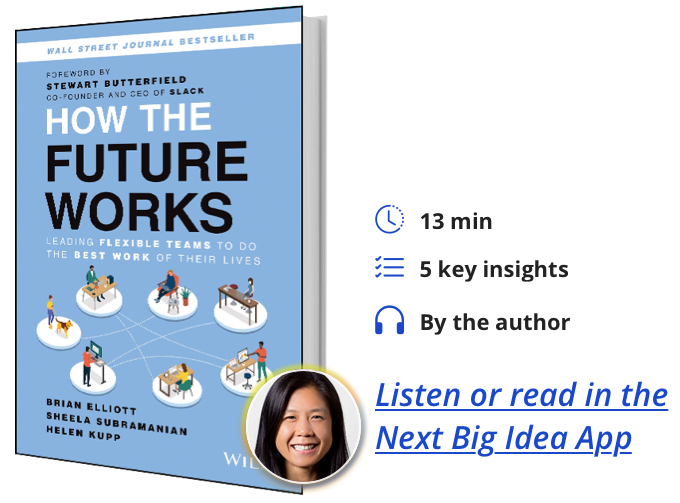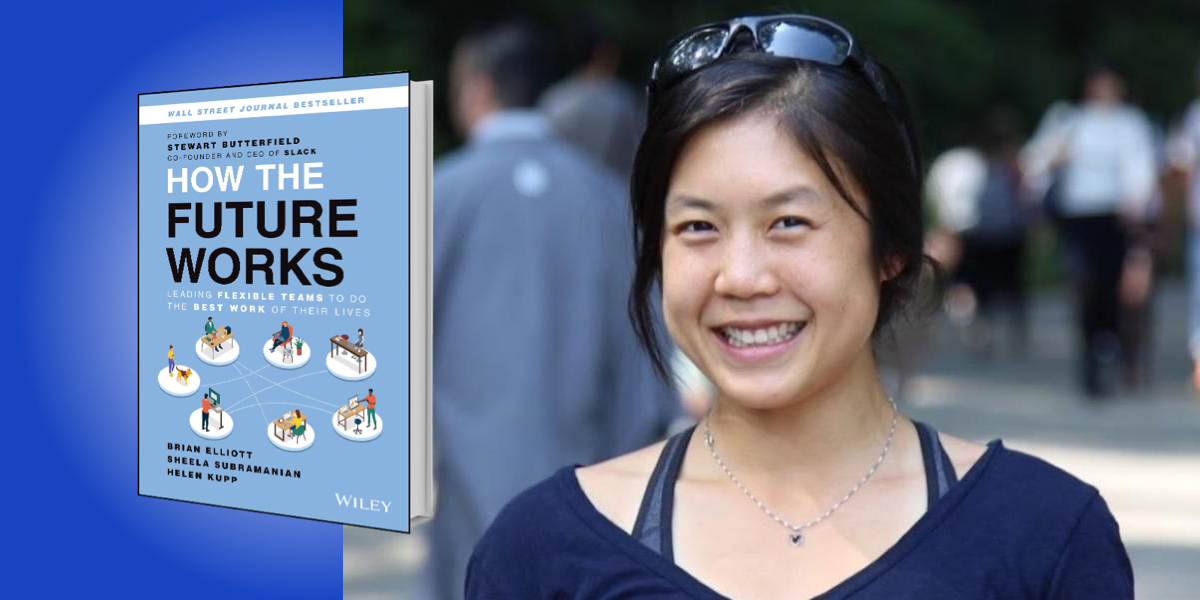Helen Lee Kupp, Sheela Subramanian, and Brian Elliott are co-founders of Future Forum, a research consortium that helps leaders redesign work to be better for people and organizations. Kupp acts as Senior Director for Future Forum, Subramanian is Vice President of Future Forum, and Elliott is Executive Leader of Future Forum.
Below, Helen shares 5 key insights from their new book, How the Future Works: Leading Flexible Teams to Do the Best Work of Their Lives. Listen to the audio version—read by Helen herself—in the Next Big Idea App.

1. The 9-to-5 doesn’t work anymore (and maybe never did).
Most of us still think of the workday as some variation of 9-to-5. Back when we were still working in offices all the time, we noticed when people arrived in the late morning, or left early at 3 pm. This continues to be true even though technology has made it possible for knowledge work to be done from anywhere, at any time.
One of the biggest silver linings of the unprecedented and difficult pandemic years is that companies, leaders, and people made discoveries about conventional wisdom that dictated so much of how we worked…that just weren’t holding up. We all thought that productivity would suffer, but it rose during the pandemic (3.1 percent during the first year of the crisis as measured by Goldman Sachs).
Curiously, we started seeing the benefits of flexibility as people settled into a rhythm of virtual work: better sense of belonging, work-life balance, and the ability to manage stress and anxiety. It’s no surprise that flexibility now ranks second only to compensation in determining job satisfaction. And 71 percent of employees are open to looking for a new job in the next year if they are dissatisfied with current levels of flexibility.
Competitive advantage comes down to attracting, engaging, and retaining top talent. As Stewart Butterfield, co-founder and CEO of Slack, once said, “The opportunity we have today is enormous. This is a chance to reimagine how work gets done, to break old habits, and make work better for people and companies.”
2. Time matters more than place.
We can often get too focused on “days in the office” when thinking about flexibility, but while many people (over three-quarters) want location flexibility, almost everyone wants schedule flexibility. It’s more valuable in unlocking productivity, reducing stress, and improving work-life balance.
“We have to stop relying on live meetings as the only way to get work done.”
A calendar full of back-to-back meetings from 9 am to 5 pm, even if it’s done via Zoom from home, is not real flexibility and it’s not what people are asking for. Everyone has different needs and different times when they feel most productive. I’m a morning person and do my best thinking before the kids get up at 7 am. My co-author Sheela is a night owl, and prefers to do her best work after dinner. Sometimes I have to do an unplanned daycare pickup because my toddler is sick. Others might want to take a midday jog while the sun is out.
We all want to work on a schedule that lets us make our lives work and do great work at the same time. For this, we have to stop relying on live meetings as the only way to get work done. Schedule flexibility is only possible if we find alternative ways to collaborate. Whether that’s brainwriting ideas before a discussion, or sending status checks in a team digital channel instead of the daily roundtable.
3. Flexibility has positive impact on diversity, equity, and inclusion.
There’s a pervasive myth that we need the office to build connections. Perhaps the most surprising finding in our research was that sense of belonging increased for people working remotely compared to the office. In particular, quarter over quarter we see sense of belonging rise for those traditionally underrepresented in knowledge work—including women, people of color, and working mothers. That’s because there’s less code switching, microaggressions, and discrimination.
But it’s also because flexible work reduces everyday points of friction. If you’re deeply introverted, you might find yourself drowned out by louder voices in a live brainstorm. Or, maybe you’re a parent and don’t want the pressure of choosing between joining a happy hour or heading home to pick up your kids from school.
While the pandemic has made it clear that long-term isolation is hard (even the deeply introverted like being around other people sometimes), we also have to recognize that traditional office culture was never the right fit for every single person.
“Perhaps the most surprising finding in our research was that sense of belonging increased for people working remotely compared to the office.”
It’s not surprising that traditionally underrepresented groups in knowledge work demand flexibility the most (38 percent of Black male employees and 33 percent of Black female employees, compared to 25 percent of white female employees and 26 percent of white male employees). This also means that enabling flexibility isn’t enough. To reduce the risk of proximity bias, leaders must be intentional about how flexible work is enabled.
4. Rebalance control and choice—trust your people.
Executives are used to command and control, but broad mandates (like a baseline of three days in-office) have faced major backlash from employees because this communicates a lack of trust by leaders in their people.
One of the executives we work with at the Future Forum, Kelly Ann Doherty, the Chief People Officer at Mr. Cooper, put it best: “People are looking for both flexibility and trust—to believe that their leaders and the company trust that they can get the work done.” I’ll add that the sentiment is especially strong because workers already proved that they can fulfill their responsibilities while under the difficult circumstances of navigating a pandemic for over two years.
In practice, leaders can establish principles and guardrails that define what flexible work means to the organization. Principles ground an approach in core company values, while guardrails guide behavior. This approach gives a framework for getting started, but also leaves room for teams to test and learn. I call this freedom within a framework.
Rather than implement broad mandates, executives need to lead by example. If all your executives come into the office five days a week, you’re signaling that while you may have flexible policies, career advancement happens if you return to the office full-time. This behavior fuels the proximity bias fire. Instead, leaders need to model flexible work and consider setting behavioral guardrails to create an equitable experience no matter where people are working from. At Slack, we got rid of the physical C-Suite—our executives are no longer solely based in San Francisco and their desks are not centralized on the top floor.
“Rather than implement broad mandates, executives need to lead by example.”
5. The job of the manager has shifted—soft skills matter more than ever.
One of the most important groups of people in making flexible work successful are middle managers. They are the linchpins for work. They make flexible principles and guardrails tangible and actionable at the team-level, and they help connect people to information and opportunities across the organization. In many ways the job of manager has shifted, but many employee managers weren’t trained to lead these new, complex teams of knowledge workers.
Most managers still rely on outdated tactics, like task-tracking or clock-watching that are not grounded in trusting your team. It’s no surprise that even after people have been working productively remotely over the last few years, managers are still wondering, “How will I know that my people are working and being productive?”
An important question that Helena Gottschling, CHRO of the Royal Bank of Canada and Future Forum executive, often asks is: “How did you know they were productive when they were in the office?” Because it’s not as different as we first assume. “It’s not like you are looking over their shoulder to see what they’re doing on a day-to-day basis in the office either.”
We have to reskill managers to do three things: inspire trust, create clarity, and unlock potential. Move away from measuring success as who shows up the earliest and stays the latest, or who responds the fastest to messages virtually. Move towards outcomes like business results, progress against a product roadmap, and employee engagement.
It all comes back to unlocking people’s unique potential. Companies who make flexible work successful will have more engaged, diverse teams and ultimately remain competitive in the long run. Flexible work is messy, but the rewards are worth it.
To listen to the audio version read by co-author Helen Kupp, download the Next Big Idea App today:































